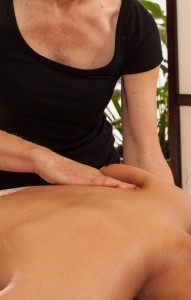 Before a massage session begins, it’s not uncommon for a massage therapist to palpate their client to get a feel for the quality of their muscle tissue and where to focus their treatment. This allows the therapist to understand what techniques to use and perhaps get an indication of the underlying problem. However, palpating without also engaging the client is a missed opportunity. If the client says the pain is “in my neck,” or “my lower back,” those are broad regions that involve a number of muscles. For example, I have a shoulder injury, where my main tension is right in my supraspinatus, but if I only say “shoulder,” therapists will work on the interior angle of my scapula, or even my lats, and barely focus at all on the supraspinatus, which is right on top of the shoulder. While palpating, asking the client to confirm where they feel their aches and pains not only allows you to be more specific in understanding where a particular injury may be, but also gives the client confidence that you are really attuned to their issues, which will make them feel more trusting and comfortable about the massage that’s about to follow. Asking a few questions lets your client know that you care by showing them that you are actively investigating their needs, rather than just going “hmmm, mmm-hmm, I see…” which can inadvertently come off as uninterested and dismissive.
Before a massage session begins, it’s not uncommon for a massage therapist to palpate their client to get a feel for the quality of their muscle tissue and where to focus their treatment. This allows the therapist to understand what techniques to use and perhaps get an indication of the underlying problem. However, palpating without also engaging the client is a missed opportunity. If the client says the pain is “in my neck,” or “my lower back,” those are broad regions that involve a number of muscles. For example, I have a shoulder injury, where my main tension is right in my supraspinatus, but if I only say “shoulder,” therapists will work on the interior angle of my scapula, or even my lats, and barely focus at all on the supraspinatus, which is right on top of the shoulder. While palpating, asking the client to confirm where they feel their aches and pains not only allows you to be more specific in understanding where a particular injury may be, but also gives the client confidence that you are really attuned to their issues, which will make them feel more trusting and comfortable about the massage that’s about to follow. Asking a few questions lets your client know that you care by showing them that you are actively investigating their needs, rather than just going “hmmm, mmm-hmm, I see…” which can inadvertently come off as uninterested and dismissive.
Some easy questions to help you clarify & confirm your client’s needs as you palpate:
“Is this where you are feeling the pain?”
“Does it ache anywhere else?”
“How far down does it go?”
“Is it tender here, too?”
When you palpate, give yourself kudos, but don’t miss the opportunity to communicate with your client and involve them in dialogue while you’re doing so. An engaged, trusting client will experience your work far more positively, making for a better experience, and better outcomes, for both of you.






I liked this article, it made me ponder, Why, in our artform, do we put so much emphasis on a cartesian approach to assessment. Why not get a more global picture with assessment since no structures in the body is truly isolated from each other.
Thanks Find Touch for your important and smart tips shared with all therapists that continue improving our knowledge to help people physically, mentally and emotionally too.
“May our hands work be a sign of reverence and gratitude to the human condition”
– Mahatma Gandhi
Namaste
Jenny Alcazar
http://www.jennyalcazar.com